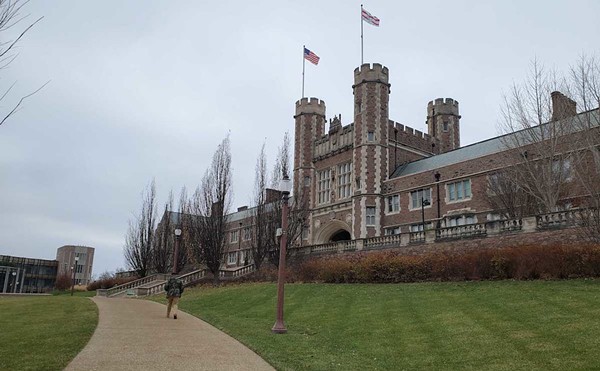Witnesses to the execution would later report that seven minutes after receiving the anesthetic, Foster was conscious and gasping for breath. At that point the blinds were lowered, concealing the execution chamber. It wasn't until nearly half an hour later, at 12:36 a.m., that prison officials opened the blinds, announcing that Foster had died three minutes earlier.
Foster's death is receiving fresh scrutiny thanks to its inclusion in a lawsuit filed in a St. Louis federal court last month. Brought on behalf of four Missouri death-row inmates, all of whom were convicted of murder, the suit alleges that the state's method of lethal injection is unconstitutional and that there is a "substantial risk that [condemned prisoners] will suffer excruciating pain during their executions."
Lawyers representing inmates Reginald Clemons, Richard Clay, Jeffrey Ferguson and Roderick Nunley are quick to point out that the suit does not seek to challenge the constitutionality of the death penalty. They question the means, not the end.
"We've seen time and time again that these executions aren't happening the way the state or their experts say they are," explains Jill O'Toole, an attorney with the New York-based law firm Simpson, Thacher & Bartlett, which represents Clemons. "We're basically advocating that they come up with a very deliberate execution process that reflects some kind of consideration by medical professionals."
Officials in Missouri and most of the other 36 states that execute inmates via lethal injection have long attempted to keep their protocols secret, but recent cases have begun to pull back the veil.
In Missouri as in most states, lethal injection is a three-step process: The anesthetic sodium thiopental (sodium pentothal) is administered, followed by pancuronium bromide (commercially known as Pavulon), which induces paralysis; last comes potassium chloride, a salt that triggers cardiac arrest. Each chemical is injected in a theoretically lethal quantity — i.e., any one of them, used by itself, is sufficient to kill a person. The doses of pancuronium bromide and sodium pentothal would cause death by suffocation after a period of time; potassium chloride instantly stops the heart.
Rarely used in today's operating rooms, sodium pentothal is known to induce unconsciousness quickly, but only for a short duration. Inmates' lawyers have argued that if it isn't administered correctly, a prisoner might awaken later in the process, fully conscious but paralyzed by the Pavulon and unable to communicate.
"The worst-case scenario is that you get a subanesthetic dose of thiopental and a paralyzing dose of pancuronium," explains Mark Heath, an anesthesiologist at Columbia University who has testified as an expert witness at many trials. "You would experience the torment of suffocation and conscious paralysis, and then the agony of the burning potassium chloride."
Once thought to be the legal equivalent of a Hail Mary pass, the strategy of challenging lethal-injection protocols has been employed more than forty times nationwide over the past two years. This is the fifth such challenge in Missouri, where inmate Timothy Johnston first raised the issue in 2004. (Johnston's unsuccessful suit was the basis for "Uncomfortably Numb," a December 15, 2004, Riverfront Times feature story that traced the origins of the three-drug sequence and how it became widely accepted. A follow-up story, "Numb and Number," appeared in this paper's October 12, 2005, edition.)
"Of the five executions in 2005, four of those inmates raised this same issue. Each time in those instances the courts ruled in our favor," says John Fougere, press secretary for Missouri Attorney General Jay Nixon and former spokesman for the state's corrections department. "Our position is that we've successfully defended in the past, and will continue to do so, that Missouri's method of execution and lethal-injection system is constitutional."
Recently, however, the legal tide appears to have shifted. Last week the U.S. Supreme Court heard oral arguments in a related case. Hill v. McDonough is a Florida case that involves a seemingly narrow question: whether a legal challenge of lethal-injection protocols is a civil rights matter or an issue that must constitute part of a prisoner's appeals process. If the state of Florida prevails, Hill and others who challenge execution protocols will be constrained by congressionally mandated limitations on so-called habeas corpus appeals. The case prompted Florida Governor Jeb Bush to announce that he would sign no more death warrants until the issue is resolved.
Nationwide, courts have stayed eight executions after inmates challenged the three-chemical sequence as cruel and unusual punishment, according to Richard Dieter, executive director of the Death Penalty Information Center, a Washington, D.C.-based nonprofit critical of capital punishment. Among those is the case of Missouri inmate Michael Taylor, whose stay of execution was upheld by the U.S. Supreme Court. Last week a panel of federal judges sent Taylor's case back to federal court in Kansas City for a new hearing.
"The country is a little more skeptical about the death penalty. It's part of the errors that were made and shown to be definitive in the late '90s and 2000s with DNA evidence: the mistakes of wrongful convictions, bad lawyering, etc.," says Dieter. "I think it exposed the death penalty to the point where it's on the defensive. There have been lethal-injection challenges for twenty years or so, but they have not been successful or caused any delays in executions. But now there's hard medical evidence that sometimes with these chemicals people are conscious and feeling what people thought they wouldn't be feeling. Every inmate who's filing an appeal is including this issue."
A California case involving rapist-murderer Michael Morales may have a direct bearing on Missouri's lethal-injection method. In February U.S. District Court Judge Jeremy Fogel determined that California's lethal-injection process was murky enough to merit the presence of either an anesthesiologist to monitor the condemned man's vital signs during the execution or a state-licensed person to inject Morales with a lethal dose of sodium pentothal and wait for it to kill him.
Fogel also rebuked Mark Dershwitz, the University of Massachusetts anesthesiologist who frequently testifies as an expert witness for the state in similar trials. In the Morales case, Dershwitz testified that "over 99.999999999999 percent" of the population would be unconscious one minute after receiving the state-specified five-gram dose of sodium pentothal, and that such a dose "would cause virtually all persons to stop breathing within a minute of drug administration."
While Fogel agreed that a prisoner would be unconscious by the time pancuronium bromide was administered, he noted the discrepancy between Dershwitz's estimates and evidence from California's execution logs, which indicated that several condemned inmates had continued to breathe long after being injected with sodium pentothal.
"Evidence...that the inmates' breathing may not have ceased as expected in at least six out of thirteen executions by lethal injection in California raises at least some doubt as to whether the protocol actually is functioning as intended," Fogel wrote.
Both the American Medical Association and the American Society of Anesthesiologists condemn physician participation in executions, and the state of California had to postpone Morales' execution indefinitely when it was unable to locate a physician willing to do the job.
"Morales is really a turning point for all lethal-injection challenges," notes Reginald Clemons' defense attorney Jill O'Toole. "Up until that decision, everyone assumed that these lethal injections were being done properly. But once people started taking a look more carefully at it, they realized that it wasn't what everyone thought."
Though the California decision carries no weight in Missouri, legal observers say Morales will likely influence similar trials here, given that the states employ the same lethal-injection protocol.
Though Missouri does not mandate autopsies on executed prisoners, at least one such autopsy was performed here: After Emmitt Foster's death by lethal injection, his mother paid for an independent autopsy.
The autopsy did not reveal whether Foster was conscious at the time of his death. But the cause of death wasn't a potassium chloride-induced heart attack; Foster died from pulmonary congestion and edema.
"It raises grave concerns about the way the execution was done," argues O'Toole. "If he had potassium chloride, he should have had cardiac arrest as his cause of death. He didn't. He [died while] struggling to breathe against a blocked airway."





